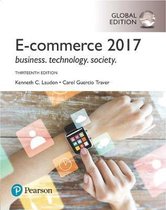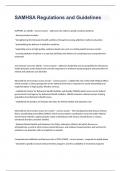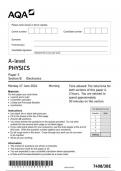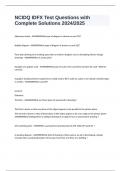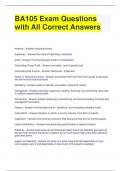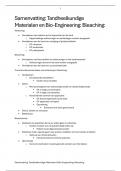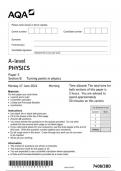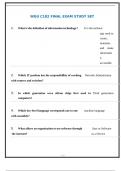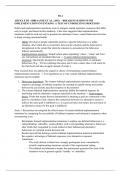Laudon, K.C., & Traver, C. G. (2017). E-commerce: business,
technology society (13th ed.) Boston: Pearson
,Informaton management for IBA
Table of Contents
Chapter 1 – Introducton to E-commerce............................................................................3
Chapter 2 – E-commerce infrastructure..............................................................................7
Chapter 3 – Building an E-commerce Presence..................................................................17
Chapter 4 – E-commerce security and payment systems...................................................27
Chapter 5 – E-commerce business models and concepts...................................................34
Chapter 8 – Ethical, Social and politcal issues in E-commerce...........................................43
Chapter 9 – Online media.................................................................................................53
Chapter 10 – Online Content and Media...........................................................................56
Chapter 11 – Online Retail and Services............................................................................57
Chapter 12 – B2B E-commerce..........................................................................................64
2
,Informaton management for IBA
Chapter 1 – Introduction to E-commerce
1.2 Introduction to E-Commerce
E-Commerce: the use of Internet, Web and mobile browsers/apps on mobile devices to
transact business.
In other words: E-commerce can be defned as digitally enabled commercial transactions
between and among organizations and individuals. It mainly involves transactions that
crosses frm boundaries. Digital transactions include all transactions by digital
technology. Commercial transactions involve exchange of value (e.g. money).
NOTE: E-Commerce ≠ E-Business
The book uses E-Business to refer primarily to enabling digital transactions and
processes within frm, involving information systems under control of the frm.
The main drivers of E-Commerce are the Internet, Web and Mobile platforms.
The Internet is a worldwide network of computer networks built on common standards.
Another driver is the World Wide Web (the Web). It is an information system that runs
on Internet infrastructure. It provides access to trillions of web pages created in language
called HTML (HyperText Markup Language). Besides this ‘visible’ web, there is also a
deep web, which is even times greater than the surface web. This other kind of web
includes databases and other content that is not indexed by search engines.
NOTE: Deep web ≠ Dark web
The newest development in Internet infrastructure is the mobile platform. It provides
the ability to access the internet from a variety of mobile devices such as smartphones.
Mobile devices are playing an increasingly prominent role in Internet access.
Recently, all forms of e-commerce continue to grow. For example, Social networks
anticipated by introducing search and buy buttons for companies. Another trend is the
growth of platforms based on smartphones and tablet computers. We all use mobile
messaging services like Whatsapp and Snapchat has created an alternative
communication. These are just two out of many emerged trends.
1.3 Unique features of E-Commerce technology
There are eight unique features of e-commerce technology that both challenge
traditional business thinking and help explain why we have so much interest in e-
commerce. Before e-commerce, marketing and sale was a mass-process, assuming that
consumers are passive targets. Consumers would be trapped by boundaries
(information asymmetry). E-Commerce technologies make it possible to know much
more about consumers and use this information more efectively (e.g. segment market in
subgroups). Also, the same technologies make it possible for merchants to know more
about other merchants.
The 8 dimensions:
1. Ubiquity
E-Commerce is characterized by its ubiquity; it is available about everywhere. It
liberates us from a physical place and enables a marketspace (a marketplace extended
beyond traditional boundaries and removed from temporal and geographic location).
Furthermore, it reduces transaction costs (e.g. costs spent on travelling) and lowers the
cognitive energy (= mental efort required to complete a task) required to transact in a
marketspace.
3
, Informaton management for IBA
2. Global reach
E-Commerce technology allows commercial transactions to cross cultural, regional and
national boundaries more efectively. Therefore, the potential market size is roughly the
size of the world’s online population.
3. Universal standards
An unusual feature of e-commerce technology is the technical standards of the internet
are universal standards. These lower market entry costs and reduce search costs (e.g.
price discovery) for the customer. In other words, it is easy to fnd many suppliers, prices
and delivery terms of a specifc product anywhere in the world.
4. Richness
Information richness refers to the complexity and content of a message. E-commerce
could even ofer more information richness than traditional markets because they are
interactive and can adjust message to individuals.
5. Interactivity
E-commerce allows for interactivity, meaning two-way communication in more ways
than traditional markets. For example, a merchant can have comment features,
community forums and social networks to interact with consumers.
6. Information density
E-commerce technologies vastly increase information density (=the total amount and
quality of information available to all market participants, consumers and merchants). E-
commerce technologies reduce information collection, storage, processing and
communication costs. At the same time, these technologies greatly increase the
currency, accuracy and timeliness of information, making it more useful and important.
This development reduces information asymmetry by, for example, price & cost
transparency.
7. Personalization and customization
E-commerce technologies permit personalization: merchants can target their
marketing messages to specifc individuals by adjusting the message to a person’s name,
interests and past purchases. For instance, showing a relevant advertisement on a
consumer’s profle.
It also comes with customization (=changing delivered product or service based on a
user’s preferences or prior behaviour).
In combination with information density, it is possible to store and use information about
prior purchases and behaviour. For instance, in the traditional situation it is possible to
choose a television channel, but not change the content of the channel. Nowadays, this is
possible.
8. Social Technology: User-generated content and social networks
E-commerce technologies have evolved to be much more social by allowing users to
create and share content with a worldwide community. Using this communication, users
are able to create new social networks and strengthen existing ones.
4

